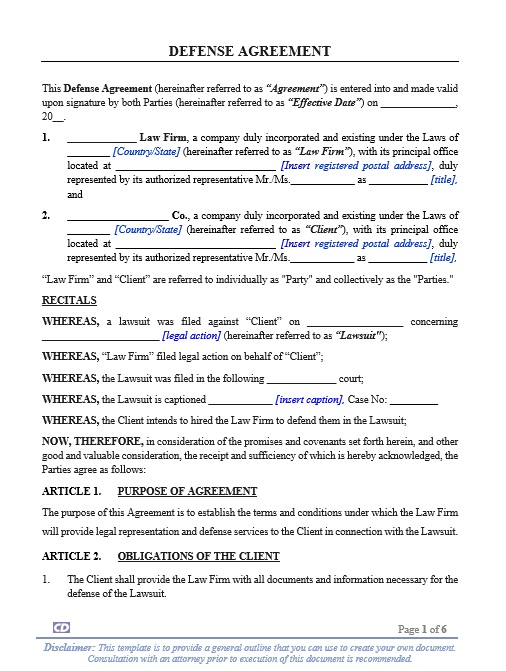Estimated reading time: 3 minutes
A Lawsuit Defense Agreement defines the obligations and responsibilities of a Law Firm and its client, detailing the terms of service, payment arrangements, and other critical elements necessary for a comprehensive legal defense.
Such an agreement ensures that the law firm commits to protecting and defending the client’s interests against the lawsuit. By engaging a law firm through a defense agreement, clients can tap into the expertise and resources of experienced attorneys specializing in the relevant law area.

Additionally, the Lawsuit Defense Agreement provides a clear framework for communication and collaboration between the law firm and the client, ensuring transparency and mutual understanding throughout the legal process. This structured approach helps both parties manage expectations and work efficiently towards a favorable outcome.
Lawsuit Concepts and Terminology
A lawsuit is a formal legal proceeding in which a plaintiff sues a defendant before a civil court. The plaintiff, claiming harm or loss from the defendant’s actions, seeks a legal or equitable remedy. The defendant must respond within a set time to avoid a default judgment.
Court Judgments and Remedies
When the plaintiff succeeds, the court may issue several types of orders. These can include awards for monetary damages, injunctions to stop certain actions, or other measures to enforce legal rights. Each order depends on the nature of the claim and the evidence presented.
Types of Legal Disputes
Lawsuits may arise under private law, which governs disputes between individuals or entities, or public law, where the state appears as a party. Civil litigation usually falls under private law, while cases involving regulation or government action belong to public law.
The Litigation Process
Litigation describes the process of managing and resolving these civil actions. Those directly involved are known as litigants, while their legal representatives are called litigators. The term litigation may also extend to certain criminal actions when prosecution and defense follow similar procedural steps.
Origin of the Term “Lawsuit”
The word lawsuit combines “law” and “suit”. The word suit comes from Old French suite or sieute, meaning to pursue or follow, which in turn derives from the Latin secutus, the past participle of sequi, meaning to follow. Similarly, the English word sue originates from Old French suir or sivre, also derived from sequi. These roots reflect the idea of pursuing a right or following a claim through the courts.
Check out more sections of our website for related content:
- Contingency Fee Agreement for Law Firms
- Franchise Agreement
- Latin Legal Terms Glossary
- International Judicial & Arbitration Bodies
References
- American Bar Association (ABA). “Understanding Legal Fees and Agreements.”
American Bar Association offers guidance on attorney-client agreements, including contingency, hourly, and defense retainers. It explains how law firms structure payment arrangements and define obligations in legal representation. - U.S. Courts. “Federal Court System in the United States.”
Administrative Office of the U.S. Courts – Provides an overview of the structure and function of the federal judicial system, outlining how lawsuits progress through courts and how legal defense processes are managed. - Cornell Law School, Legal Information Institute (LII). “Lawsuit.”
Cornell LII – Defines lawsuits, litigation procedures, and key terminology used in civil and criminal actions. It also clarifies distinctions between plaintiffs, defendants, and the roles of attorneys in court proceedings.
has been added to your cart!
have been added to your cart!



